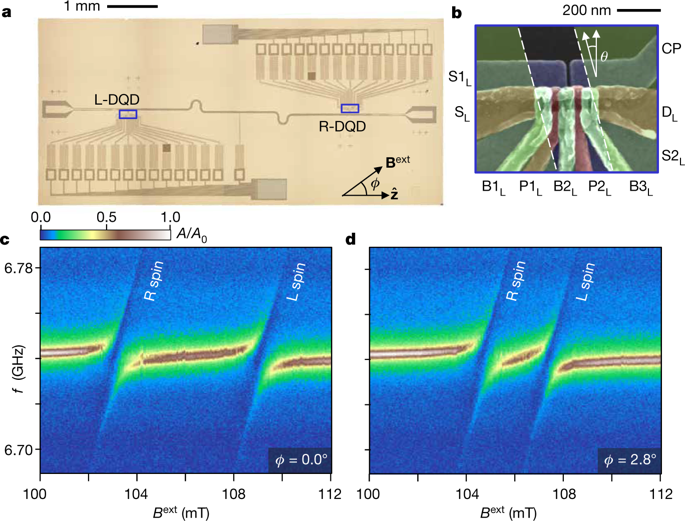Our official English website, www.x-mol.net, welcomes your
feedback! (Note: you will need to create a separate account there.)
Resonant microwave-mediated interactions between distant electron spins
Nature ( IF 50.5 ) Pub Date : 2019-12-25 , DOI: 10.1038/s41586-019-1867-y F Borjans 1 , X G Croot 1 , X Mi 1, 2 , M J Gullans 1 , J R Petta 1
Nature ( IF 50.5 ) Pub Date : 2019-12-25 , DOI: 10.1038/s41586-019-1867-y F Borjans 1 , X G Croot 1 , X Mi 1, 2 , M J Gullans 1 , J R Petta 1
Affiliation

|
Nonlocal qubit interactions are a hallmark of advanced quantum information technologies 1 – 5 . The ability to transfer quantum states and generate entanglement over distances much larger than qubit length scales greatly increases connectivity and is an important step towards maximal parallelism and the implementation of two-qubit gates on arbitrary pairs of qubits 6 . Qubit-coupling schemes based on cavity quantum electrodynamics 2 , 7 , 8 also offer the possibility of using high-quality-factor resonators as quantum memories 3 , 9 . Extending qubit interactions beyond the nearest neighbour is particularly beneficial for spin-based quantum computing architectures, which are limited by short-range exchange interactions 10 . Despite the rapidly maturing device technology for silicon spin qubits 11 – 16 , experimental progress towards achieving long-range spin–spin coupling has so far been restricted to interactions between individual spins and microwave photons 17 – 20 . Here we demonstrate resonant microwave-mediated coupling between two electron spins that are physically separated by more than four millimetres. An enhanced vacuum Rabi splitting is observed when both spins are tuned into resonance with the cavity, indicating a coherent interaction between the two spins and a cavity photon. Our results imply that microwave-frequency photons may be used to generate long-range two-qubit gates between spatially separated spins. Microwave-mediated coupling of electron spins separated by more than 4 mm is demonstrated, suggesting the possibility of using photons at microwave frequencies to create long-range two-qubit gates between distant spins.
中文翻译:

远距离电子自旋之间共振微波介导的相互作用
非局部量子位相互作用是先进量子信息技术的标志 1 – 5 。在远大于量子位长度尺度的距离上传输量子态和产生纠缠的能力大大增加了连接性,并且是实现最大并行性和在任意量子位对 6 上实现两个量子位门的重要一步。基于腔量子电动力学 2、7、8 的量子位耦合方案也提供了使用高质量因数谐振器作为量子存储器 3、9 的可能性。将量子位交互扩展到最近邻之外对于基于自旋的量子计算架构特别有益,这些架构受到短程交换交互 10 的限制。尽管用于硅自旋量子位 11 – 16 的设备技术迅速成熟,迄今为止,实现远程自旋-自旋耦合的实验进展仅限于单个自旋和微波光子之间的相互作用 17-20。在这里,我们展示了物理分离超过四毫米的两个电子自旋之间的共振微波介导耦合。当两个自旋都与腔共振时,观察到增强的真空 Rabi 分裂,表明两个自旋和腔光子之间存在相干相互作用。我们的结果意味着微波频率光子可用于在空间分离的自旋之间产生远程双量子位门。证明了电子自旋的微波介导耦合相隔超过 4 毫米,这表明使用微波频率的光子在远距离自旋之间创建远程双量子位门的可能性。
更新日期:2019-12-25
中文翻译:

远距离电子自旋之间共振微波介导的相互作用
非局部量子位相互作用是先进量子信息技术的标志 1 – 5 。在远大于量子位长度尺度的距离上传输量子态和产生纠缠的能力大大增加了连接性,并且是实现最大并行性和在任意量子位对 6 上实现两个量子位门的重要一步。基于腔量子电动力学 2、7、8 的量子位耦合方案也提供了使用高质量因数谐振器作为量子存储器 3、9 的可能性。将量子位交互扩展到最近邻之外对于基于自旋的量子计算架构特别有益,这些架构受到短程交换交互 10 的限制。尽管用于硅自旋量子位 11 – 16 的设备技术迅速成熟,迄今为止,实现远程自旋-自旋耦合的实验进展仅限于单个自旋和微波光子之间的相互作用 17-20。在这里,我们展示了物理分离超过四毫米的两个电子自旋之间的共振微波介导耦合。当两个自旋都与腔共振时,观察到增强的真空 Rabi 分裂,表明两个自旋和腔光子之间存在相干相互作用。我们的结果意味着微波频率光子可用于在空间分离的自旋之间产生远程双量子位门。证明了电子自旋的微波介导耦合相隔超过 4 毫米,这表明使用微波频率的光子在远距离自旋之间创建远程双量子位门的可能性。











































 京公网安备 11010802027423号
京公网安备 11010802027423号